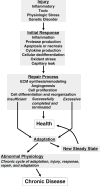A conceptual framework for the molecular pathogenesis of progressive kidney disease
- PMID: 20352456
- PMCID: PMC5558437
- DOI: 10.1007/s00467-010-1503-4
A conceptual framework for the molecular pathogenesis of progressive kidney disease
Abstract
The data regarding the pathogenesis of progressive kidney disease implicate cytokine effects, physiological factors, and myriad examples of relatively nonspecific cellular dysfunction. The sheer volume of information being generated on this topic threatens to overwhelm our efforts to understand progression in chronic kidney disease or to derive rational strategies to treat it. Here, a conceptual framework is offered for organizing and considering these data. Disease is initiated by an injury that evokes a tissue-specific cellular response. Subsequent structural repair may be effective, or the new structure may be sufficiently changed that it requires an adaptive physiological response. If this adaptation is not successful, subsequent cycles of misdirected repair or maladaptation may lead to progressive nephron loss. To illustrate how this framework can be used to organize our approach to disease pathogenesis, the role of cytokines in proteinuria and progressive glomerular disease is discussed. Finally, this theoretical framework is reconsidered to examine its implications for the diagnosis and treatment of clinical conditions. Application of this schema could have significant relevance to both research inquiry and clinical practice.
Figures



References
-
- Coresh J, Selvin E, Stevens LA, Manzi J, Kusek JW, Eggers P, Van Lente F, Levey AS. Prevalence of chronic kidney disease in the United States. JAMA. 2007;298:2038–2047. - PubMed
-
- Thurau K, Boylan JW. Acute renal success. The unexpected logic of oliguria in acute renal failure. Am J Med. 1976;61:308–315. - PubMed
-
- Ross R. Atherosclerosis-an inflammatory disease. N Engl J Med. 1999;340:115–126. - PubMed
-
- Bricker NS, Fine LG, Kaplan M, Epstein M, Bourgoignie JJ, Light A. “Magnification phenomenon” in chronic renal disease. N Engl J Med. 1978;299:1287–1293. - PubMed
Publication types
MeSH terms
Substances
Grants and funding
LinkOut - more resources
Full Text Sources
Medical

